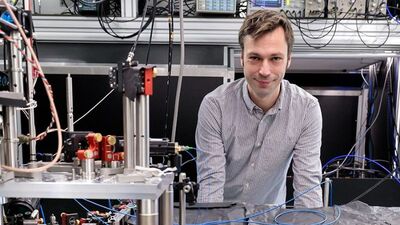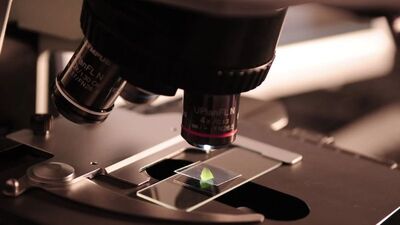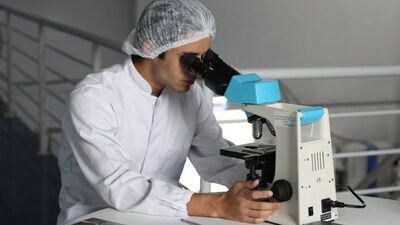News from June 2023
‘Noise-cancelling’ qubits developed at UChicago to minimize errors in quantum computers
By DOE Newswire Report | Jun 24, 2023
Despite their immense promise to solve new kinds of problems, today’s quantum computers are inherently prone to error.
HERACLES beamline to accelerate cathode research
By DOE Newswire Report | Jun 24, 2023
Cornell is breaking new ground in electron beam research with the HERACLES beamline, a state-of-the-art electron gun that mimics the harsh environments of the world’s largest particle colliders.
Resolving a Mathematical Puzzle in Quarks and Gluons in Nuclear Matter
By Alyssa Marie Dasal | Jun 24, 2023
The building blocks of atomic nuclei are protons and neutrons, which are themselves made of even more fundamental particles: quarks and gluons.
A Low-Energy ‘Off Switch’ for Quark-Gluon Plasma
By DOE Newswire Report | Jun 24, 2023
Physicists can create an exotic state of matter known as a quark-gluon plasma (QGP) by colliding gold nuclei together.
Energy Department discusses ANR Pipeline Company; Notice of Request Under Blanket Authorization and Establishing Intervention and Protest Deadline on June 23
By DOE Newswire | Jun 24, 2023
The US Energy Department published a two page notice on June 23, according to the U.S. Government Publishing Office.
Scientists Develop Inorganic Resins for Generating and Purifying Radium and Actinium
By DOE Newswire Report | Jun 24, 2023
Targeted alpha therapy can destroy cancerous cells without harming healthy cells.
Getting to the Bottom of When the Smallest Meson Melts
By DOE Newswire Report | Jun 24, 2023
Theorists have performed calculations to predict the temperature at which bottomonium mesons will melt.
Researchers Demonstrate First Precision Gene Editing in Miscanthus
By DOE Newswire Report | Jun 24, 2023
Adaptable and easy to grow, miscanthus (or silvergrass) shows great potential as a sustainable bioenergy crop.
Getting to the Bottom of When the Smallest Meson Melts
By DOE Newswire Report | Jun 24, 2023
Theorists have performed calculations to predict the temperature at which bottomonium mesons will melt.
To Advance Microbiome Research, the National Microbiome Data Collaborative Ambassador Program Promotes Microbiome Data Standards
By DOE Newswire Report | Jun 24, 2023
Researchers have predicted that our planet may be home to one trillion species of microbes.
STAR Physicists Track Sequential ‘Melting’ of Upsilons
By DOE Newswire Report | Jun 24, 2023
Scientists use the Relativistic Heavy Ion Collider (RHIC), a Department of Energy user facility, to recreate and study the hot particle soup that existed in the very early universe.
Directly Imaging Quantum States in Two-Dimensional Materials
By DOE Newswire Report | Jun 24, 2023
When some semiconductors absorb light, excitons (or particle pairs made of an electron bound to an electron hole) can form.
Fusion Simulations Reveal the Multi-Scale Nature of Tokamak Turbulence
By DOE Newswire Report | Jun 24, 2023
Creating efficient, self-sustaining fusion power requires good confinement of the heat in the plasma.
DOE Announces Over $21 Million to Advance Commercialization of Clean Energy Solutions
By DOE Newswire | Jun 24, 2023
Release: New Investments Will Increase Access to Clean Energy Technologies and Support America’s Transition to a Clean Energy Economy
New nontoxic powder uses sunlight to quickly disinfect contaminated drinking water
By DOE Newswire Report | Jun 24, 2023
A low-cost, recyclable powder can kill thousands of waterborne bacteria per second when exposed to sunlight.
Landmark yeast study provides framework for understanding biodiversity, applications
By DOE Newswire Report | Jun 24, 2023
Better understanding of the family responsible for nearly all bread, fermented drinks, and biofuels creates a path to finding new strains with potentially useful traits.
Clemson University team leads sustainable energy research
By DOE Newswire Report | Jun 24, 2023
A group of Clemson University researchers led a study that was recently published in the journal Nature Communications and is aimed at developing advanced materials for mitigating greenhouse gas emissions and building a clean and sustainable energy future.
A Nanocrystal Shines On and Off Indefinitely
By DOE Newswire Report | Jun 24, 2023
In 2021, lanthanide-doped nanoparticles made waves—or rather, an avalanche—when Changwan Lee, then a PhD student in Jim Schuck’s lab at Columbia Engineering, set off an extreme light-producing chain reaction from ultrasmall crystals developed at the Molecular Foundry at Berkeley Lab.
Scientists report world’s first X-ray of a single atom in Nature
By DOE Newswire Report | Jun 24, 2023
Ateam of scientists from Ohio University, Argonne National Laboratory, the University of Illinois-Chicago, and others, led by Ohio University Professor of Physics, and Argonne National Laboratory scientist, Saw Wai Hla, have taken the world’s first X-ray SIGNAL (or SIGNATURE) of just one atom.
Graduate Student Selected for DOE Research Program at Sandia National Lab
By DOE Newswire Report | Jun 24, 2023
The Department of Energy’s (DOE’s) Office of Science has selected physics graduate student Adam Christensen from The University of Texas at Austin to participate in the Office of Science Graduate Student Research (SCGSR) Program.














